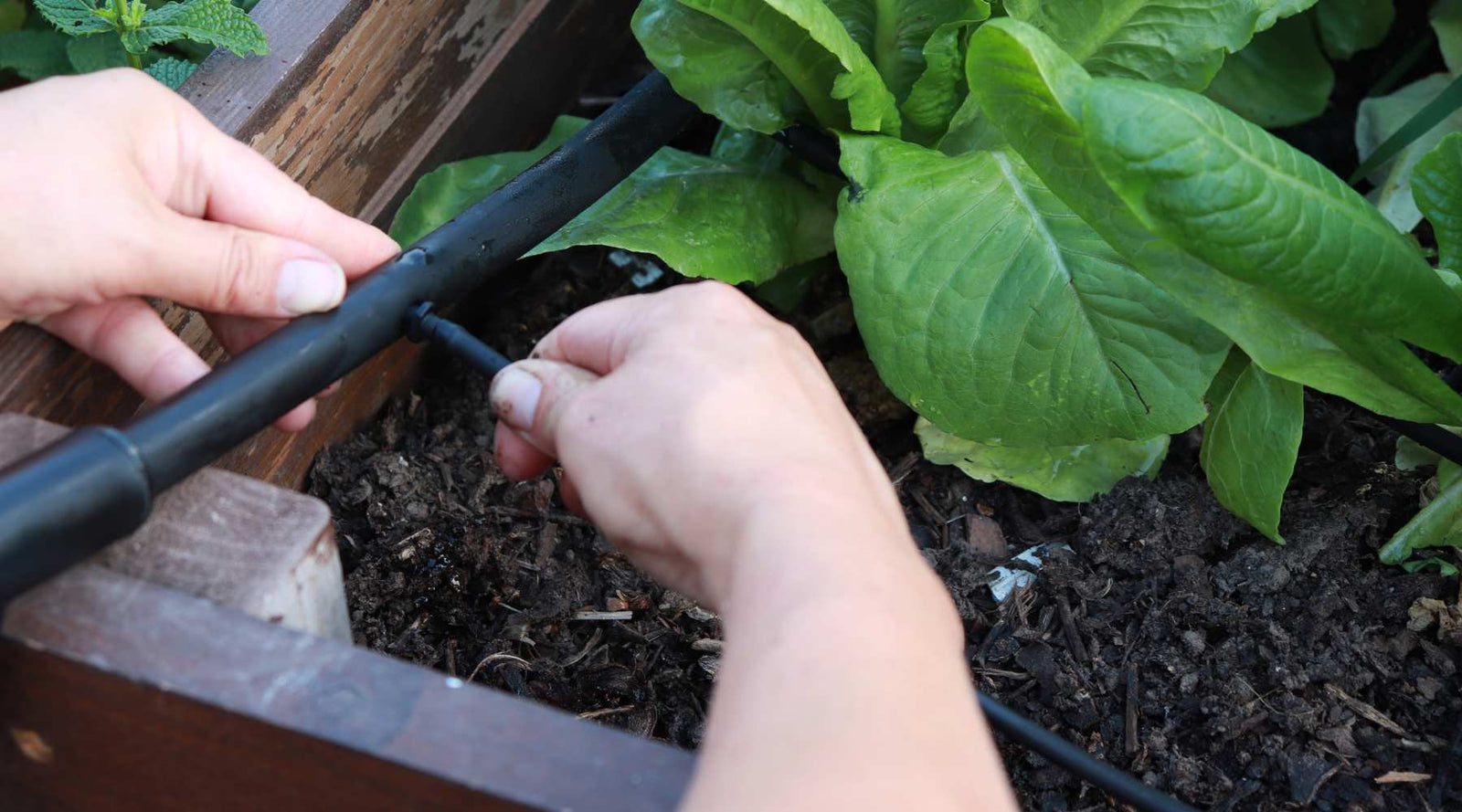Free Shipping on Orders over $75 to the Contiguous US
Free Shipping on Orders over $75 to the Contiguous US
The Best Drip Irrigation for Container Gardening in Small Scale Gardens
August 29, 2023 6 min read 0 Comments

Are you looking for the best drip irrigation for raised beds or containers? Drip irrigation is a reliable, sustainable way to ensure that your crops get adequate moisture, right where it is needed.
The key to a thriving garden lies in the proper watering system. Among the various irrigation options available, drip irrigation stands out as the most efficient and beneficial watering system for raised beds. This guide will explore the features, benefits, and installation process of the best drip irrigation for raised beds.
Understanding the Basics of Drip Irrigation
Drip irrigation is a watering technique that slowly delivers water directly to the plant roots. This method of irrigation is beneficial for raised bed gardens for a number of reasons. First, it conserves water by reducing evaporation and runoff. Secondly, it prevents waterborne diseases and mold growth by keeping the plant leaves dry. Lastly, it allows for targeted watering, ensuring that each plant receives the right amount of water. Check out our extensive guide on drip irrigation for a deeper understanding if you will be using drip systems for larger row style crops.

The Benefits of Drip Irrigation in Container Gardens
1. Efficient Use of Water Resources
One of the major advantages of drip irrigation is its water efficiency. By delivering water directly to the root zone of plants, drip irrigation reduces the amount of water lost to evaporation or runoff.
2. Easy Installation and Maintenance
Good irrigation systems come with instructions and the set up is a series of repeated steps that are easy to master. Maintaining the system requires only occasional repairs and end of season flushing.
3. Improved Plant Growth and Health
Excess moisture on plant leaves can lead to the spread of fungal diseases. Since drip irrigation systems deliver water directly to the root zone, the leaves of the plants remain dry, reducing the risk of disease.
When water stressed many plants will not only have wilted leaves, they will also drop their flowers and cease fruit production. Consistency of moisture also avoids plant stress resulting in optimal vegetative growth. When it comes to fruit production in plants like cucumbers consistent water application is key in consistent flowering and fruiting.
4. Cost Efficiency Compared to Other Systems
Watering can be an expensive process, particularly if you live within city limits and are paying by the gallon for your water use. The targeted application of water in a drip system limits overwatering and overly expensive water bills. It also limits the time you need to spend standing around with a hose.
5. Easily Control Water Flow and Intensity
With a drip irrigation system, you can control exactly where the water goes, ensuring that each plant receives just the right amount of water. With a kit that includes preinstalled emitters, we recommend varying your spacing to accommodate different watering requirements. For high water needs place plants every 4 inches, for lower need plants space every 6-12 inches.

Maximizing Space with Microclimates
As your passion for gardening grows, you may wish you could grow more variety in your space. One of the best ways to accomplish this is with microclimates. By creating microclimates in your garden you can grow heat-loving crops alongside cool crops.
By intentionally creating a garden plan and using shade cloth, you can create warmer or cooler microclimates to allow you to grow crops as much as 2-3 zones beyond your location. Amazing!
Comparing Types of Watering Systems for Container Gardens and Raised Beds
When it comes to watering your raised beds, you have several options to choose from. Here's a comparison of the most common watering systems:
Garden Hose
A garden hose is a basic and straightforward method of watering plants. However, it requires manual operation and can lead to uneven watering.
Soaker Hoses
Soaker hoses are a type of porous hose that allows water to seep out slowly along its length. These hoses can be laid out in your raised beds, providing a slow and steady supply of water to your plants. However, they can be difficult to install and may not provide uniform watering.
Sprinkler Systems
Sprinkler systems are another common method of watering raised bed gardens. While they can cover a large area, they also lead to a lot of water wastage due to evaporation. Moreover, they can promote the spread of diseases by wetting the leaves of the plants.
Drip Irrigation
Drip irrigation systems are the most efficient and effective method of watering raised beds. They deliver water directly to the root zone of the plants, ensuring uniform watering and reducing the risk of disease. They are simple to install and can be automated with a timer for ease of use.

Investing in the Right Drip Irrigation System
Once you have decided to install a drip irrigation system, it's important to invest in the right equipment. Here are a few things to consider:
Main Water Source
The first step in setting up a drip irrigation system is to identify your main water source. This could be a rain barrel, a well pump, or a spigot on your house. The type of water source will determine the complexity of your irrigation system and the necessary components.
Hose Diameter
The diameter of the hose you choose for your drip irrigation system will determine the amount of water delivered to your plants.
Water Pressure
The water pressure of your system is another important factor to consider. Most drip irrigation systems operate effectively at 25 psi, although some can handle lower pressures. Too low or too high water pressure can lead to inconsistent watering or damage to the system.
Additional Equipment
Aside from the main components, there are several additional pieces of equipment you might need for your drip irrigation system. These include pressure regulators, timers, filters, and water softeners.
Setting Up Your Drip Irrigation System
It can be easy to feel overwhelmed when setting up a drip irrigation system for your raised beds or container garden. This is why we recommend the Raised Bed Drip Irrigation Kit.
It includes everything you need to water 150 square feet of garden space. Plus, multiple kits can be connected to cover more than 700 square feet.
- Attach to Water Source - Start by determining where the drip irrigation kit will attach to your main water source.
- Lay Out Main Line - Next, you’ll want to lay out your main water line. This line is 50 feet long. You can easily lay it across multiple raised beds or an array of containers.
- Add Drippers - Lastly, you can attach drippers. Some kits will have these drip emitters preinstalled into the drip line. This allows you to place a dripper right at the bottom of a plant, which is especially useful for minimizing water waste.

FAQs on Drip Irrigation for Raised Beds
Let's address some commonly asked questions about drip irrigation for raised beds:
Q: What is the best type of drip irrigation system for raised beds and small scale container gardening?
A: The Drip Irrigation Kit makes watering raised beds simple and straightforward. It comes with everything you need to create a watering system for your raised beds and container gardens.
Q: How often should I water my raised beds with a drip irrigation system?
A: The frequency of watering will depend on the specific needs of your plants, the local climate, and the time of year. However, as a general rule, most raised beds will need to be watered 1-3 times per week.
Q: How to choose the right drip irrigation system?
A: The right drip irrigation system choice for your garden will depend on the crops that you grow, the amount of water flow available, your water source, and your budget. We recommend getting an irrigation system sized properly for your space, and one that can run on an automated timer.
Q: How do you install a drip irrigation system for container gardening?
A: Follow the instructions that come with your kit carefully. Many kits are designed to be used within certain water limits and exceeding these will reduce the performance of your system and may lead to uneven watering.
Q: What are the pros and cons of using a drip irrigation system for container gardening?
A: Pros-
- Easy to automate watering with a timer
- No water waste
- No leaf wetting
- Easy to install
Cons-
- Added expense of a system
- Maintenance required
- Occasional overhead watering should be done to “wash your leaves.”
- If you do not have an automated shut off timer, you NEED to remember to shut it off.
Q: Are there any special considerations for using a drip irrigation system for container gardening in hot climates?
A: Yes, drip irrigation in hot climates may need to be adjusted to more frequent watering at shorter durations on super hot days. It is also advisable to schedule most of your watering overnight when evaporation is less and the water in the lines is not hot. For more on Keeping Plants Alive in a Drought you can review this article.
Conclusion
In conclusion, employing the best drip irrigation for raised beds and container gardens can make a significant difference in the health and productivity of your garden. By delivering water directly to the root zone of plants, drip irrigation conserves water, prevents disease, and ensures that each plant receives the precise amount of water it needs to thrive. With careful planning and installation, a drip irrigation system can be a game-changer for any raised bed or container garden.
Subscribe
Sign up to get the latest on sales, new releases and more …
